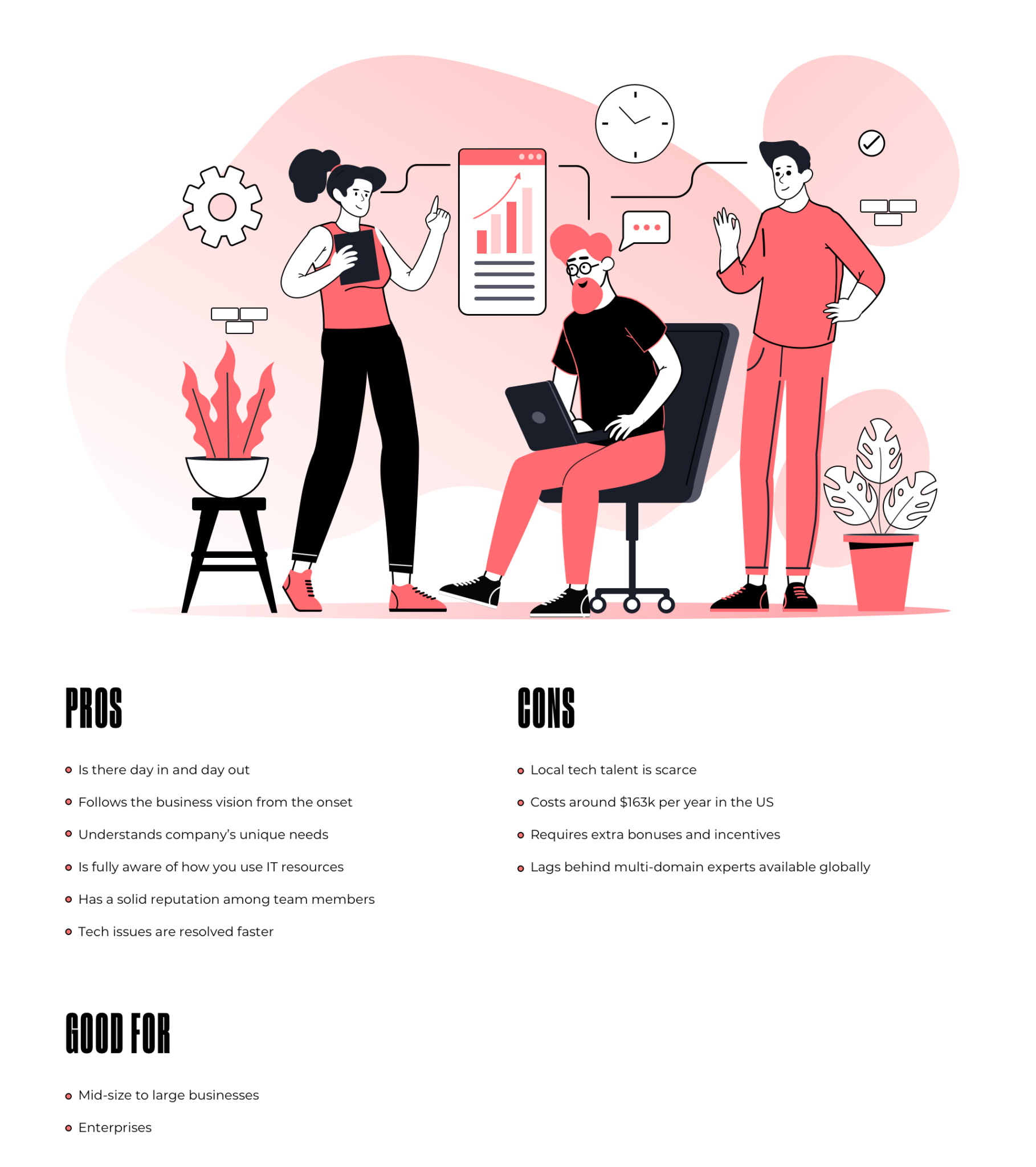
BEING A VIRTUAL CTO IS MORE THAN JUST GIVING ADVICE: AN INSIDE PEEK
For the second year in a row, the COVID-19 pandemic is forcing companies to adopt a digital approach to their day-to-day running. According to Gartner, 58% of business leaders have been investing big in emerging technology in 2021, and are planning to do so further on. The key initiative behind the increased spendings is to accelerate business growth by means of innovation.
The strategic importance of innovation for modern-day companies is hardly disputable. The business environment is evolving and all legacy methods of operation are being upgraded. Essentially, it sounds like a good idea that will pay off over time. It really is, but there’s also a flip side to this. It’s called business capacity.
Can you afford to spend an average of 10-15% of your total revenue on technology that may fail to drive your business forward?
More often than not, the answer will be ‘No’.
To implement new tech a company needs a wealth of talent, a scalable infrastructure in place, and a strategy for continuous growth. Otherwise, those spendings will be vain, while technologies will bring no expected transformation.
This is why your business needs a Chief Technology Officer. You can opt for an in-house expert or a virtual CTO.
WHAT IS A VIRTUAL CTO? [DEFINITION]

Either virtual or on-site, a Chief Technology Officer (CTO) is a C-level executive, who oversees the company’s digital infrastructure and makes sure that short- and long-term goals of the business are achieved by utilizing innovative tech. A CTO stays on top of the emerging software trends, evaluates them in the context of business needs, maps out the tech strategy, and decides on the procedures necessary for delivering high-quality products or services.
What do fellow CTOs say?
“The job of a CTO is to work with a CEO and other business leaders and ensure that you’re implementing a technology vision that supports the strategy of the business.”
OUTSOURCED CTO VS IN-HOUSE CTO
Over the recent turbulent years, the business world has become accustomed to working remotely. The transition to all-digital space has blurred the lines between local and offshore experts. Companies now have access to tech talent anywhere in the world at a low operational cost.
You may conclude that it speaks in favor of virtual CTO services, but there are certain nuances that you have to bear in mind before committing to outsourcing.
INTERNAL CTO: PROS & CONS

CTO AS A SERVICE: PROS & CONS

THE VARYING ROLE OF A VCTO
The responsibilities of an on-demand CTO are evolving along with the environment that companies are now operating in. They become more cross-functional and strategy-oriented. Providing CTO services no longer means consulting on tech gaps or managing the IT infrastructure. It’s about helping to build a data-driven business.
The modern role of a CTO is multi-faceted, so they perform functions that are seemingly inherent to other roles. There’s often an overlap of the duties performed by a CIO and CTO, as well as a VP of Engineering and CTO.
What do fellow CTOs say?
“[The role of a CTO] is dynamic… You’re wearing a lot of different hats. You really can’t confine yourself to one way of thinking… You’re immersing yourself in so many different verticals.”
Peter Shankar, a CTO at Equity Multiple

A CTO-AS-A-SERVICE CASE IN POINT
Let’s conduct a short opinion poll.
Imagine that there’s a client running an online store. The client aims at recording the 20x increase in the number of sold goods. Can a CTO help achieve this ambitious goal?
- YES
- NO
In fact, the right answer is ‘Yes’. And that’s exactly what we are working on now.
At the onboarding stage, we conducted a series of interviews with the client to get their business vision and end goals. Those goals were achievable through automating part of manual processes like adding goods to the platform.
The next step was to actually try and find the solution that would fit this exact business and its operating model. So, we plunged into experimenting. Using a lean approach, the tech team worked out a concept for further validation. We outlined the specifics for the required automation algorithm and proceeded to its development.
Upon deploying this algorithm, we’ve managed to triple the system’s capacity. Technically, we could improve it more, but in the long term, this would not be enough. The solution alone would not be able to bring us to the mark of 20x. To reach the desired goal we have to dive into the business processes and transform them too, using the trial-and-error method.
Is this case a success? Yes, for sure. We created the appropriate automation tool and its implementation results pointed us towards other bottlenecks that we need to resolve. Our cooperation with the client is in progress. We are now devising a strategic roadmap that may help us bring more transformations to internal processes and eventually, drive the client’s business growth.
KEY TAKEAWAY
The job of a CTO is to deal with complex business problems that do not have a straightforward solution.
A CTO does not only give advice on the issue that a company faces. A CTO dives into this issue and maps out the appropriate ways of solving it. More so, these new ways must correlate with the existing work processes and fall within the company’s vision.
HOW TO HIRE A VIRTUAL CTO SERVICE?

By this point, you might have decided that your business needs a CTO’s virtual assistance. But there’s a catch. You shouldn’t go for ANY provider.
Whether or not your choice is going to be a success depends on many factors, and you, as a business owner, are capable of minimizing the risk of failure.
You should have a clear vision of where your business is now and where you want it to be over time; as well as understand which exact role you are going to assign to a CTO on demand. The CTO’s responsibilities transform in accordance with the stage your business is at.
SET THE END GOALS
Do you want to build an MVP? Are you trying to get the most out of your tech team and improve the internal processes? Are you looking for ways to meet customers’ current and future demands?
Know where you want to focus the efforts of a CTO and outline OKR.
DEFINE REQUIREMENTS FOR THE ROLE
You need to decide whether a CTO should be more of a techie or a strategist. Based on the chosen direction, you may or may not require a candidate to have coding skills, QA & testing experience, engineering mindset, etc.
Ideally, you want to find someone who is technically relevant, and also speaks the language of business.
CTOs are transformational leaders and therefore, should approach business growth both technically and strategically. We’ve expanded on this in our interview with Peter Shankar, so make sure to check it for lots of insights.
ASK YOUR CONTACTS FOR ADVICE
Don’t underestimate the power that word of mouth has in hiring C-suite executives.
Talk to business owners that have a CTO on their team or have collaborated with a CTO service provider recently. Also, utilize online networking platforms like LinkedIn and visit tech events or meetups.
ASK GOOGLE
Surf the net for the list of outsourcing companies that provide development and consulting services. As a rule, they also showcase a portfolio of completed projects. Through case studies, you can learn about CTO solutions provided and decide whether it is something you are looking for or not.
Make sure to also check business rating platforms like Clutch. There, you will most likely find reviews and feedback of the provider’s real customers.
OR… SKIP THE ABOVE AND CONTACT CXDOJO
CXDojo has been in the industry since 2014. So, we had enough time to handpick the right talent and learn to deliver the expected results together. Our tech leaders are there to pick up your project at any stage, be it a pure idea or a working product that needs improvement.
Let’s have a chat and find the exclusive solution that will fully support your business goals! Shall we?
Author
back to all postsOUR RECENT PROJECTS
 Product launch with agile methodology
Product launch with agile methodology
- social platform
- iterative development
- user testing
- continuous improvement






